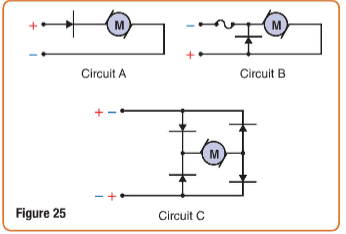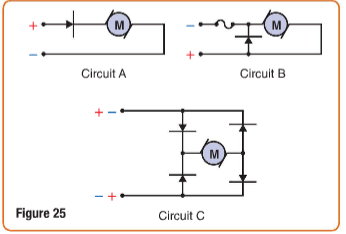
(a)
The circuit which allows the motor to run in only one direction.
(a)
Answer to Problem 74A
In circuit A, the motor runs in one direction.
Explanation of Solution
Given:
The figure:

As per problem
Consider the circuits in given figure
In circuit A, the forward biased diode is in series with the motor, so the current flows through the motor directly.
In circuit B, the diode is in parallel with the motor, so the current id divided between the diode and the motor.
In circuit C, there are two series diode connected parallel to each side of the motor, hence again the current is divided and the motor does not runs in a single direction.
Hence only in circuit A, the motor runs in one direction.
Conclusion:
In circuit A, the motor runs in one direction.
(b)
The circuit which will cause a fuse to blow if the incorrect polarity is applied.
(b)
Answer to Problem 74A
The circuit B will cause the fuse to blow if the incorrect polarity is applied.
Explanation of Solution
Given:
The figure:

In circuit B, a fuse is connected in series with the parallel circuit of motor and diode. If incorrect polarity, that is, positive terminal is connected to the fuse directly, it will overload and blow.
Conclusion:
The circuit B will cause the fuse to blow if the incorrect polarity is applied.
(c)
The circuit that produces the correct direction of rotation irrespective of the polarity applied.
(c)
Answer to Problem 74A
The circuit C produces the correct direction of rotation irrespective of the polarity applied.
Explanation of Solution
Given:
The figure:

In circuit C, either of the diodes connected to the left side of the motor will be forward-biased irrespective of the polarity applied. Subsequently the diodes connected on the right side of the motor will be forward biased or reverse-biased depending on the biasing of the right hand side diodes. Thus s the motor will rotate in the correct direction irrespective e of the polarity.
Conclusion:
The circuit C produces the correct direction of rotation irrespective of the polarity applied.
(d)
The advantages and disadvantages of the three circuits.
(d)
Answer to Problem 74A
The circuit A has the advantage of simplicity, the motor runs in one direction only.
Its disadvantage is the diode voltage drop is y
The circuit B has the advantage that the diode voltage y
Its disadvantage is that the fuse may blow if polarity is incorrect.
The circuit C has the advantage that the motor runs in correct direction irrespective of the polarity.
Its disadvantage is that 1
Explanation of Solution
Given:
The figure:

The circuit A has the advantage of simplicity, the motor runs in one direction only.
Its disadvantage is the diode voltage drop is
The circuit B has the advantage that the diode voltage
Its disadvantage is that the fuse may blow if polarity is incorrect.
The circuit C has the advantage that the motor runs in correct direction irrespective of the polarity.
Its disadvantage is that
Chapter 29 Solutions
Glencoe Physics: Principles and Problems, Student Edition
Additional Science Textbook Solutions
Conceptual Physics (12th Edition)
Essential University Physics: Volume 2 (3rd Edition)
Physics for Scientists and Engineers: A Strategic Approach with Modern Physics (4th Edition)
College Physics: A Strategic Approach (4th Edition)
Physics for Scientists and Engineers: A Strategic Approach, Vol. 1 (Chs 1-21) (4th Edition)
 College PhysicsPhysicsISBN:9781305952300Author:Raymond A. Serway, Chris VuillePublisher:Cengage Learning
College PhysicsPhysicsISBN:9781305952300Author:Raymond A. Serway, Chris VuillePublisher:Cengage Learning University Physics (14th Edition)PhysicsISBN:9780133969290Author:Hugh D. Young, Roger A. FreedmanPublisher:PEARSON
University Physics (14th Edition)PhysicsISBN:9780133969290Author:Hugh D. Young, Roger A. FreedmanPublisher:PEARSON Introduction To Quantum MechanicsPhysicsISBN:9781107189638Author:Griffiths, David J., Schroeter, Darrell F.Publisher:Cambridge University Press
Introduction To Quantum MechanicsPhysicsISBN:9781107189638Author:Griffiths, David J., Schroeter, Darrell F.Publisher:Cambridge University Press Physics for Scientists and EngineersPhysicsISBN:9781337553278Author:Raymond A. Serway, John W. JewettPublisher:Cengage Learning
Physics for Scientists and EngineersPhysicsISBN:9781337553278Author:Raymond A. Serway, John W. JewettPublisher:Cengage Learning Lecture- Tutorials for Introductory AstronomyPhysicsISBN:9780321820464Author:Edward E. Prather, Tim P. Slater, Jeff P. Adams, Gina BrissendenPublisher:Addison-Wesley
Lecture- Tutorials for Introductory AstronomyPhysicsISBN:9780321820464Author:Edward E. Prather, Tim P. Slater, Jeff P. Adams, Gina BrissendenPublisher:Addison-Wesley College Physics: A Strategic Approach (4th Editio...PhysicsISBN:9780134609034Author:Randall D. Knight (Professor Emeritus), Brian Jones, Stuart FieldPublisher:PEARSON
College Physics: A Strategic Approach (4th Editio...PhysicsISBN:9780134609034Author:Randall D. Knight (Professor Emeritus), Brian Jones, Stuart FieldPublisher:PEARSON





